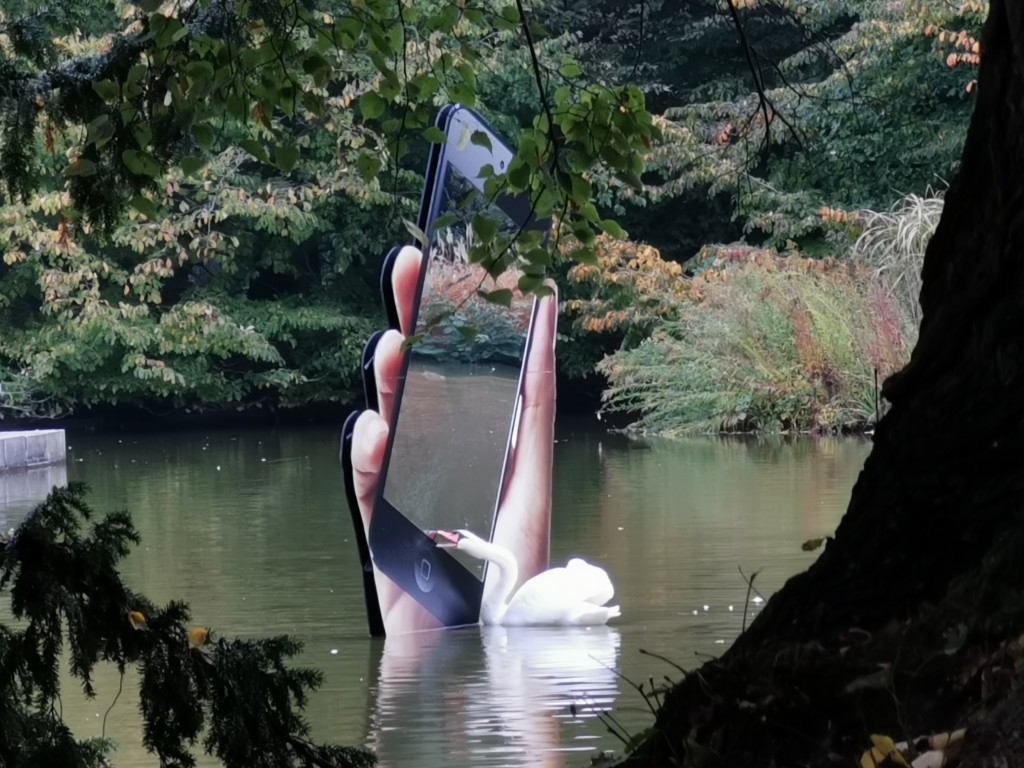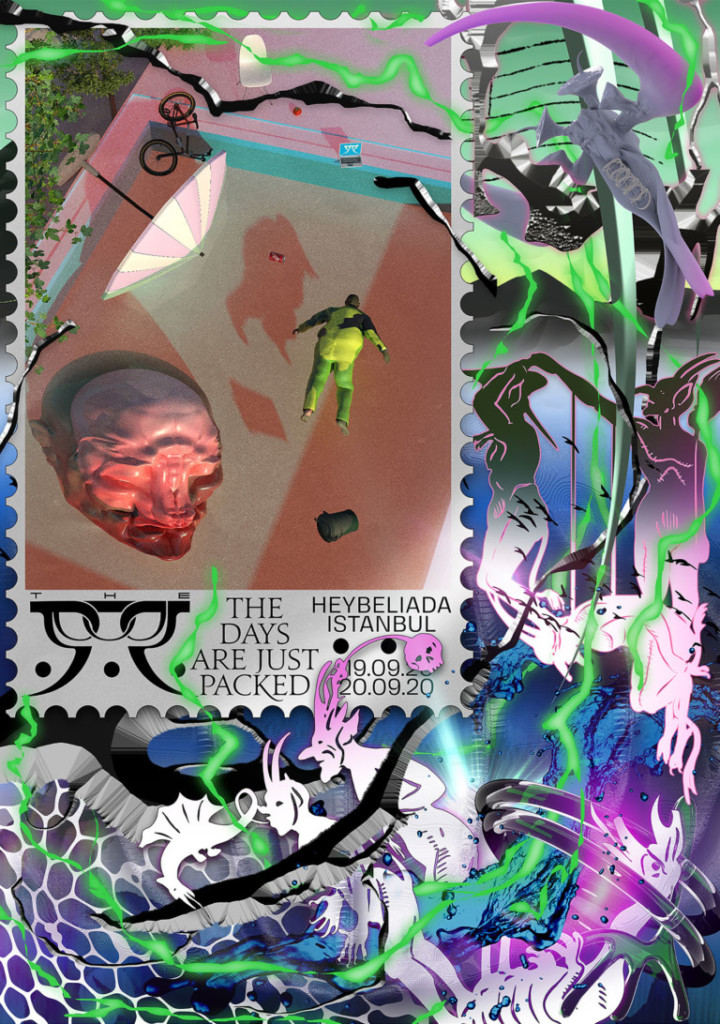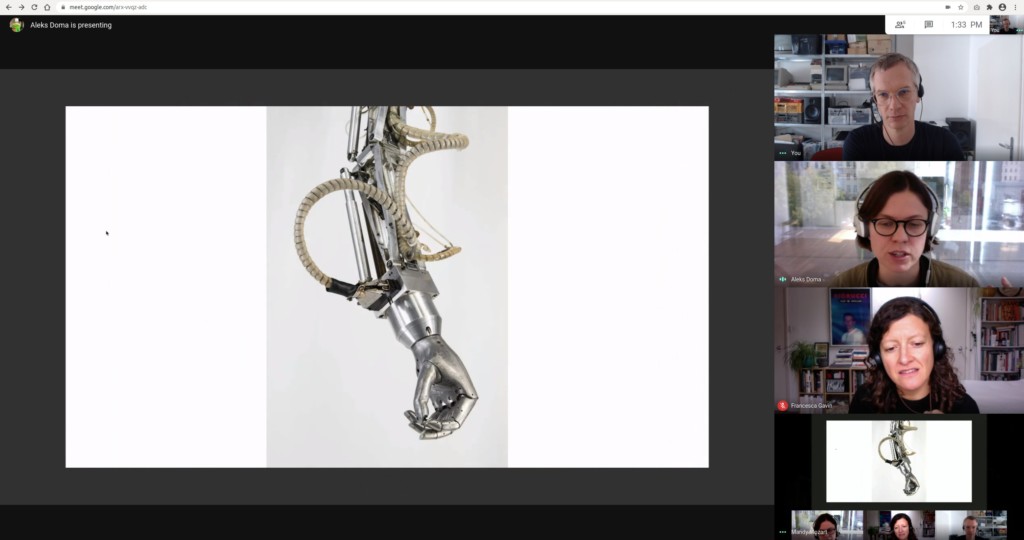Swan Presence

A swan obsessed with Obsolete Presence. Picture by Simon Fischer: CC BY 2.0
Seasons of Mediaarts, ZKM Karlsruhe 2020
For the exhibition “Home Smart Home,” Aram Bartholl equips the tower of the Kunstverein Rotenburg with a variety of home surveillance cameras. In addition to hidden cameras, known as “Nanny Cams,” Bartholl also experiments with 360° “Lightbulb” cameras equipped with lights and speakers. The market for surveillance cameras in the private sphere has grown tremendously in recent years. The desire for control over one’s own private space is reflected in this development and is part of the digitally driven society marked by a loss of trust.
The Art Tower, 4 Floors – 122 Steps – 24 m.
Originally slated for demolition in the mid-90s to make way for parking space for the “Ronolulu” leisure pool, the disused fire brigade water tower was on the chopping block. However, Peter Möhl, the former managing director of the municipal utilities and thus the owner of the tower, envisioned a meaningful repurposing. Together with the vice chairman of the Art Association, architect Jürgen Lohmann, the idea was born to convert the tower into a gallery.
Die Ausstellung Decoding the Black Box bringt Künstlerinnen und Künstler zusammen, die Licht in diesen dunklen Raum und die Prozesse werfen, die sich in ihm ereignen. Sie legen dabei nicht nur die Funktionsweisen digitaler Technologien wie beispielsweise von künstlicher Intelligenz offen, sondern visualisieren zugleich die Auswirkungen, die sie auf unsere Wahrnehmung von Realität und unser In-der-Welt-Sein haben. Während sie die ökonomischen und machtpolitischen Strukturen der digitalen Technologien und insbesondere des Internets transparent machen, zeigen sie Gegenentwürfe für eine dezentralisierte, humanere und demokratischere Nutzung ebendieser auf.
14:00 – 16:00
Killyourphone is an open workshop format. Participants are invited to make their own signal blocking phone pouch. In the pouch the phone can’t send or receive any signals. It is dead! This workshop was run for the first time at the Chaos Communication Congress in Hamburg end of 2013.
Monday 25th of March, 7:00 PM at Web Cafe, Eptanisou 40, 113 61 , Kypseli – Athens
with:
!Mediengruppe Bitnik with Selena Savić & Gordan Savičić , Ingrid Hideki, Joanna Bacas, Kyriaki Goni, Maria Mavropoulou, Marina Gioti, Marsunev, Nadja Buttendorf, Theo Triantafyllidis
Curated by Aram Bartholl & Socrates Stamatatos
Speed Show lands in Greece, the country of souvlaki, the sun (yes we can claim that they originated a celestial body), ouzo, feta, an enormous financial debt. Currently, Greece is also trending for all the wrong reasons namely, gentrification, queerphobia, state crimes and more dystopic incidents.
As 2024 unfolds, we find ourselves amidst a whirlwind of confusion, bombarded with a cacophony of online horrors to consume, an attention span further abbreviated by TikTok’s algorithm and the barrage of incoming stitches.
Stitches Incoming serve as a conduit for creators to engage and converse, traversing from one topic to the next. They have evolved into a new social fabric, weaving connections within an ever-shifting digital and physical landscape while also serving as a testament to personal and collective traumas, both past and present.
What unites the participating digital artists? Perhaps everything and nothing simultaneously… Departing from the traditional Speed Show setup, where artworks are carefully stacked inside internet cafe computers, and drawing inspiration from the structure of TikTok stitches, each piece seems to propel the conversation forward, or perhaps uses the next as a springboard for its own narrative.
Stitch this and stitch that, we have everything you ever wanted (maybe) ! Are we stuck in an infinite loop of sh*tposting, valuable content, the highlight of social issues, personal and interpersonal experiences?
Maybe! Come and find out…
More info on Speed Shows at https://speedshow.net/stitch-incoming/
14:00 – 16:00
Killyourphone is an open workshop format. Participants are invited to make their own signal blocking phone pouch. In the pouch the phone can’t send or receive any signals. It is dead! This workshop was run for the first time at the Chaos Communication Congress in Hamburg end of 2013.
14:00 – 16:00
Killyourphone is an open workshop format. Participants are invited to make their own signal blocking phone pouch. In the pouch the phone can’t send or receive any signals. It is dead! This workshop was run for the first time at the Chaos Communication Congress in Hamburg end of 2013.

A swan obsessed with Obsolete Presence. Picture by Simon Fischer: CC BY 2.0
Seasons of Mediaarts, ZKM Karlsruhe 2020

This is a physical and metaphorical pool.
19. & 20.9.2020
THE POOL
Heybeliada – İstanbul
Curated by Ece Cangüden & Marian Luft
View documentation –> http://thepool.space/the-days-are-just-packed
with/ Accel Arcana, Adrian Altman, Albin Looström, Alessandro Nucci, Alexandra Koumantaki, Ana Castillo, Anastasia Bay, Andrew Rutherdale, Anna Slama & Marek Delong, Anna Walther, Aram Bartholl, Arthur Golyakov, Ben Sang, Berkin Gülten, Bernhard Holaschke, Bob Bickell-Knight, Bora Akıncıtürk, Buğra Erol, Botond Keresztesi, Cem Örgen, Christian Bär, Christian Kölbl, Christian Schellenberger, Clemens Reinecke, Daniel Peder Askeland, Don Elektro, Felix Amerbacher, Felix Thiele, Filippo de Marchi, Florian Birk, František Hanousek, George Jacotey, Naomi Gilon, Hanna Stiegeler, Hugo Laporte, Iain Ball, İlayda Tunca, Ivan Pérard, Jakub Hajek, Jakub Hošek, Jean-Damien Charmoille, Jennifer İpekel, NDRAP Development / Jens Ivar Kjetså, Jeronim Horvat, Jirka Pfahl, Joachim Coucke, Johanna Blank, Johanna Invrea, Julie Maurin, Julien Saudubray, Julius Heinemann, Julius Pristauz, Justin Ortiz, Kaan Ülgener, Karoline Schneider, Katya Quel Elizarova, Kerim Zapsu, Kid Xanthrax, Kıvılcım Güngörün, Korto Bojovic Amar, KOTZ, Leon Leube, Lucia Leuci, Maya Hottarek, Mert Diner, Undergroundflower, Merve İşeri, Michala Paludan, Michèle Pagel, Miguel Martin, Mikkel Carl, Naomi Gilon, Neckar Doll, Nicolas Pelzer, Nik Timková, Omsk Social Club, Oya Kalkavan, Özgür Can Taşcı, Paul Barsch, Paul Bowler, Peggy Pehl, Pınar Marul, Salvador Marino, Sarah Ancelle Schönfeld, Sascha Mikloweit, Selver Yıldırım, Seyhan Musa, Şiir, Sirmon SR, Sophia Oppel, Ștefan Tănase, Steffen Zillig, Stine Deja, Süper Normal, Szilvia Bolla, Thea Mantwill, Tissue Hunter, Ute Richter, Vanya Venmer, Vilte Fuller, Vitaly Bezpalov, Vojtěch Hlaváček, Yein Lee, Zeynep Birced
In the swimming pool of the lost paradise that keeps its former glory alive by the wildness of weeds. We take you in from the lower entrance of the land, which is covered with iron bars. You climb up the ivy tunnel wrapped in rusty iron construction and reach into the realm of that anything and everything is true if you simply believe it to be true!
THE POOL sustains the future, where the dirty, deadly and almost lost one will be reproduced as a magnificent source of life.
THE DAYS ARE JUST PACKED
The physical manifestation of our online beings
As a fluid leaking out of the digital purgatory
We are spreading momentary existences
Ruins from today‘s prophecies
Just as stone tablets
Mutating in reverse
Dear post-social primates
You are the territory
Even if you are far
You can be close
Creations from a Polluted Lagoon: The Pool’s debut show on Heybeliada / Review by Matt Hanson on Exhibist.
https://exhibist.com/creations-from-a-polluted-lagoon-the-pools-debut-show-on-heybeliada/
I m very pleased to announce that my work Obsolete Presence, currently on view at ZKM Karlsruhe has finally made it to the stock photo website Shutterstock. This is in particular interesting because I’ve been working with watermarked stock photo since a few years now. The circle has finally closed. :))
All pics tagged with Bartholl on Shutterstock here.

Aleksandra Domanovic talking about an original robot arm from Yugoslavia of the 70’s.
Vienna Contemporary
Sunday, 27 September 2020, 1:30-2:30 pm
ArtTech Talk: Technology Off Screen
Artists are increasingly using new techniques and materials that address our relationship to a technological world. Artist Aleksandra Domanovic emerged with work that directly addressed a screen context with her collaborative project vvork.com before establishing a largely sculptural practice that incorporates 3D printing and ideas around the use of technology and biological innovations. Aram Bartholl is a Berlin-based conceptual artist whose work unpicks the digital and the physical in inventive ways.
Speakers:
Aleksandra Domanovic, artist
Aram Bartholl, artist
Moderated by Francesca Gavin, art theorist, curator and writer